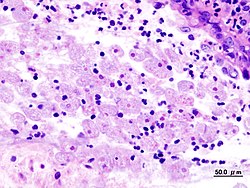Amoebiasis
Amoebiasis, also known as amebiasis or entamoebiasis,[1][2] is an intestinal infection caused by amoebas of the Entamoeba group. The infection is usually caused by Entamoeba histolytica.[3] The infection is normally got when someone drinks water with the parasite in it.
In some cases, the parasite lives in a person's large intestine and does not cause any symptoms. Symptoms vary from serious to none at all. There may be abdominal pain, mild diarrhoea, bloody diarrhoea or severe colitis with tissue death and perforation. This last complication may cause peritonitis. People affected may develop anaemia due to loss of blood.[3]

Amoebiasis is usually transmitted by water contaminated with faeces. It can also be got indirectly by contact with dirty hands or objects.
Infection is spread by ingesting the cyst form of the parasite. This tough and semi-dormant structure is found in faeces. Since amoebiasis is transmitted by contaminated food and water, it is often endemic in parts of the world with poor sanitation (such as México, Central America, western South America, South Asia, and western and southern Africa).[4]
Amoebic dysentery is often confused with "traveller's diarrhoea" because of its prevalence in developing nations. In fact, most traveller's diarrhoea is bacterial or viral in origin.
E. histolytica infections occur in both the intestine and (in people with symptoms) in tissue of the intestine and/or liver.[4] So, two different classes of drugs are needed to treat the infection, one for each location. Such anti-amoebic drugs are known as amoebicides.
Amoebiasis Media
References
- ↑ "Entamoebiasis - MeSH - NCBI". www.ncbi.nlm.nih.gov. Retrieved 2015-07-21.
- ↑ "Entamoebiasis". mesh.kib.ki.se. Archived from the original on 2015-07-22. Retrieved 2015-07-21.
- ↑ 3.0 3.1 Farrar, Jeremy et al 2013. Manson's tropical diseases. Elsevier Health Sciences, 664–671. ISBN 9780702053061
- ↑ 4.0 4.1 Ryan KJ; Ray CG, eds. (2004). Sherris Medical Microbiology (4th ed.). McGraw Hill. pp. 733–8. ISBN 0-8385-8529-9.





